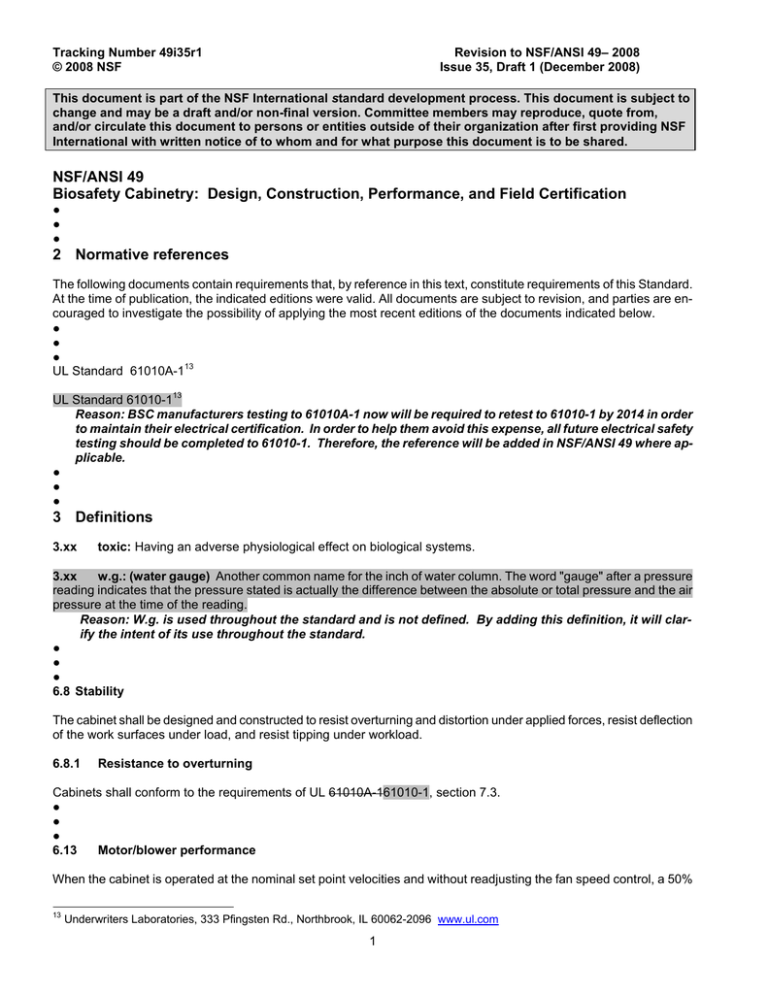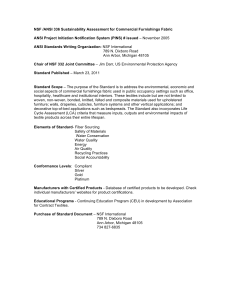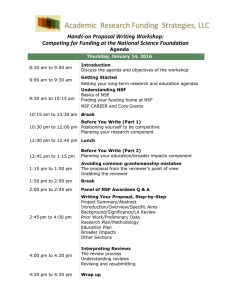UL reference- and Annex F
advertisement

Tracking Number 49i35r1 © 2008 NSF Revision to NSF/ANSI 49– 2008 Issue 35, Draft 1 (December 2008) This document is part of the NSF International standard development process. This document is subject to change and may be a draft and/or non-final version. Committee members may reproduce, quote from, and/or circulate this document to persons or entities outside of their organization after first providing NSF International with written notice of to whom and for what purpose this document is to be shared. NSF/ANSI 49 Biosafety Cabinetry: Design, Construction, Performance, and Field Certification ● ● ● 2 Normative references The following documents contain requirements that, by reference in this text, constitute requirements of this Standard. At the time of publication, the indicated editions were valid. All documents are subject to revision, and parties are encouraged to investigate the possibility of applying the most recent editions of the documents indicated below. ● ● ● UL Standard 61010A-113 UL Standard 61010-113 Reason: BSC manufacturers testing to 61010A-1 now will be required to retest to 61010-1 by 2014 in order to maintain their electrical certification. In order to help them avoid this expense, all future electrical safety testing should be completed to 61010-1. Therefore, the reference will be added in NSF/ANSI 49 where applicable. ● ● ● 3 Definitions 3.xx toxic: Having an adverse physiological effect on biological systems. 3.xx w.g.: (water gauge) Another common name for the inch of water column. The word "gauge" after a pressure reading indicates that the pressure stated is actually the difference between the absolute or total pressure and the air pressure at the time of the reading. Reason: W.g. is used throughout the standard and is not defined. By adding this definition, it will clarify the intent of its use throughout the standard. ● ● ● 6.8 Stability The cabinet shall be designed and constructed to resist overturning and distortion under applied forces, resist deflection of the work surfaces under load, and resist tipping under workload. 6.8.1 Resistance to overturning Cabinets shall conform to the requirements of UL 61010A-161010-1, section 7.3. ● ● ● 6.13 Motor/blower performance When the cabinet is operated at the nominal set point velocities and without readjusting the fan speed control, a 50% 13 Underwriters Laboratories, 333 Pfingsten Rd., Northbrook, IL 60062-2096 www.ul.com 1 Tracking Number 49i35r1 © 2008 NSF Revision to NSF/ANSI 49– 2008 Issue 35, Draft 1 (December 2008) This document is part of the NSF International standard development process. This document is subject to change and may be a draft and/or non-final version. Committee members may reproduce, quote from, and/or circulate this document to persons or entities outside of their organization after first providing NSF International with written notice of to whom and for what purpose this document is to be shared. increase in pressure drop across the new filter shall not decrease total air delivery more than 10%. 6.14 Electrical safety The cabinet shall conform to the requirements of UL 61010A-161010-1. ● ● ● A.7 Stability tests A.7.1 Purpose These tests demonstrate the structural integrity and stability of a biosafety cabinet for the following: – resistance to overturning under applied forces (refer to UL 61010A-161010-1) cited in 6.8.1 of this Standard); – resistance to distortion under applied forces; – resistance to deflection of work surfaces under load; and – stability with respect to tipping under load. Tests are performed by applying static force loads, as described below, and measuring the distortion or deflection within the cabinet. ● ● ● F.1 Field certification preconditions and intervals This annex contains the field tests that define the methods and acceptance criteria that are appropriately applied for determining qualification for field certification of all Class II biological safety cabinets. These field certification procedures are intended to confirm that an installed cabinet evaluated under the current version of the Standard has met all design criteria contained in NSF/ANSI 49 and currently meets all criteria contained in this annex. All cabinets shall be field tested using the procedures described in NSF/ANSI 49, annex F – 2002, with the exception of the downflow velocity test. When the downflow velocity test is performed, the procedure by which the cabinet was certified should be used; however, the acceptance criteria outlined in the 2002 standard shall be applied. Downflow velocity readings shall be taken four inches (ten centimeters) above the bottom edge of the window only when so stated on the manufacturer’s data plate label or when the manufacturers’ data plate label indicates the cabinet was listed to NSF/ANSI 49-2002 or later. Reason: This will update that field certification must adhere to the requirements of the current version of the standard with the exception of the downflow velocity test. ● ● ● F.8 Electrical leakage and ground circuit resistance and polarity tests All new cabinets shall conform to UL 61010A-161010-1. Older cabinets shall conform to UL 61010A-1 or may refer to NSF 49 – 1992 for Electrical Leakage, Ground Circuit Resistance, and Polarity tests if necessary. ● ● ● 2

